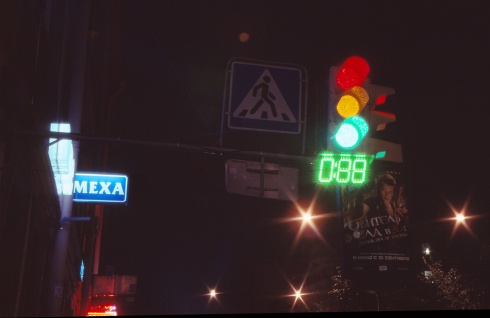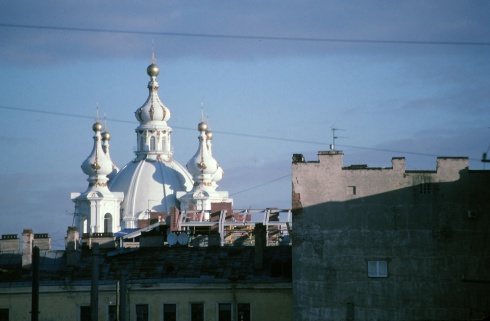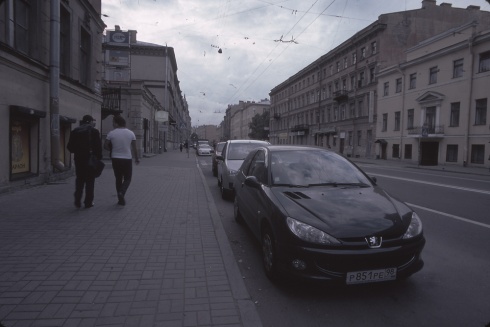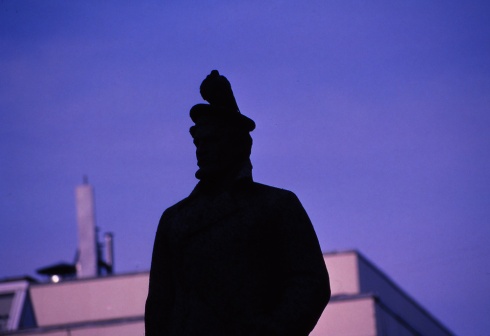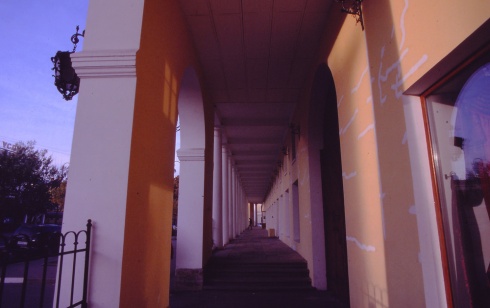This is the first of planned 10 or 12 Kodachrome-related posts, each will display roughly 10 Kodachrome images.
I wrote this on December 30 but apparently did not publish the article (New Year Eves tend to be hectic). The photos below were made with Zenit E camera (Kodachrome 64) and old Minolta SLR (Kodachrome 200). This first batch consists of 10 photos of St. Petersburg taken in immediate vicinity of my St. Petersburg home. Click the image for a larger version (contact me if you need really huge files for whatever reason).
Today is the day Kodak turned off Kodachrome’s life support.

St. Vladimir Square (Vladimirskaä Ploşad', Владимирская площадь, Vladimirskaya) Kodachrome St. Petersburg (Autumn 2010), Russia - baroque St. Vladimir Cathedral and (ugly) Dostoevskiï (Dostoevsky) monument. Dostoevskiï lived about 200 meters to the right from this spot.
On December 30, Kodak or rather its subcontractor Dwayne’s Photo Lab in Kansas, USA, officially stopped processing Kodachrome. A few of my first and last Kodachrome rolls were made for the US market and the rest was sold in Europe. US-market Kodachrome came back as if it were processed by Dwayne’s (well, as it was), each film in a plastic box with Dwayne’s label on it while the film that was sold in Europe came in original-yellow Kodachrome packaging, each slide frame numbered and bearing Kodak logo. Although the official date of Kodachrome’s demise is December 30, 2010, it reportedly continued to live for almost three weeks a while after its death. Apparently an avalanche of film engulfed Dwayne’s Photo in the last weeks of November 2010 (I think the shutoff date was December 26) and the company kept processing film until January 18, 2011, according to Kodachrome project’s blog from December 26th to 1:36 PM on the 18th (of January), Dwayne’s Photo processed 20,564 rolls of 35mm, 3,565 of 8mm and 57,655 feet of 16mm Kodachrome motion and still picture film.
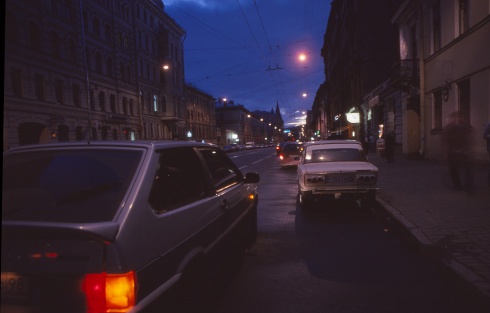
Кирочная - Kiročnaä Ulica - Kirochnaya or Kirche Street - the street where I live in St. Petersburg (about 1.5 km from the previous image), St Petersburg Saint Petersburg Russia
While for US-born Americans Kodachrome was something of a cultural icon, for me it did not mean much. I knew that in the past there were other color film processes like the Franco-English Dufay color, French Autochrome and Autochrome based Alticolor, beautiful Agfacolor that preceded Kodachrome by 3 years, never mind that on the smaller scale level there were a few Russian color photography pioneers from the turn of the century era like brilliant Sergueï Prokoudine-Gorsky (in US publication his name also gets spelled as Sergei Prokudin-Gorsky) who left a workable though complicated additive color process along with thousands of color photographs illustrating daily life of the entire Russian Empire which he took well before (first!) world war and Bolshevist coup which brought it down. I will publish all of Prokoudine-Gorsky /Прокудин-Горский photographs in a separate gallery one day; those pictures are amazing and they are all in public domain . Prokoudine-Gorsky’s photographs are surreal. It is a time machine which for me is somewhat scary to use, I don’t like looking at those images, – I would rather not see how our past looked like. if there is any I would prefer to have it in monochrome.

A corner building and full moon over Theatre Square (Театральная площадь) or rather improbably in English though closer to the original as Theatrical Square - Theatralnaä Ploşad' phonetically rendered as Teatralnaya St. Petersburg, Russia Saint Petersburg Kodachrome
Yes I’ve heard about Kodachrome and its commercial success in the 40s and 50s but I thought that Kodachrome was so overwhelingly triumphant against its European competition primarily because by 1945 entire Europe – from Atlantic almost to the Urals – was destroyed and the USA got healthy and rich by sucking all the juices from the rest of the planet. Something it still does though markedly less successfully. There are many claims of Kodachrome’s technical superiority. That’s a matter of taste but yes, I too prefer the look of Kodachrome to say Agfacolor. Now – after having been digital user for quite long – I realize that one of film’s greatest attractions is its diversity. Every film has its own characters, temperament, unique shades and different colors (if it is color film) while with a digital camera you are stuck with one boring sensor or the future of churning out Photoshop forgeries.
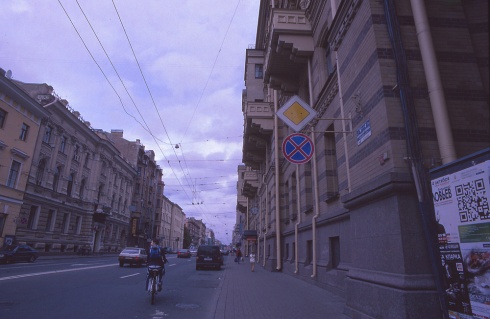
Day time at Kirche street from Foundry Avenue - the street where I live in St. Petersburg (about 1.5 km from the previous image), St Petersburg Saint Petersburg Russia Kodachrome late October - 2010 - (Kirochnaia, Litejny) - Кирочная - Kiročnaä Ulica - Kirochnaya or Kirche Street
But I admit that out of four contemporaries – Agfacolor, Dufay, Lumière’s Autochrom in its numerous varieties and Kodachrome, I like Kodak’s stuff best. It is not naturalistic looking but it is natural, Kodachrome is also rich, it has deep beautiful hues and tones that range from etherial otherworldly warmth to steely blue. Kodachrome was fantastic stuff but it took me long time to find that out. More recent films and expensive digital reproduce reality more accurately but to me another attraction of old or unusual film stocks is that they don’t, film distorts reality, life documented on Kodachrome is fairly close to the real chromatic thing but is not quite there, it is different, and it is beautiful

two girls (click for larger picture) - I see just two females in the frame more could be lurking - (Kirochnaia, Litejny) - Кирочная - Kiročnaä Ulica - Kirochnaya or Kirche Street
I am not a walking Xerox copier and when I need accuracy of color rendition, my Sony A900 does the job way better than does Kodachrome. Skin tones in Kodachrome can appear earthly grayish and the look of the film is that of remote past, it is or rather it was a photographic time machine, it is the way of representing the present in the past, a delicious endeavor (there are still many opportunities to make pictures with historic color film stocks though no longer with Kodachrome)

domes of the Resurrection of Our Savior Cathedral from afar , popularly known as the Tar (Smolny) Cathedral from 18th century works that produced shipbuilding pitch pine tar. Saint / St Petersburg, Russia 2010 late October Kodachrome
After the United States dressed warmly in a NATO’s fig leaf unleashed a humanitarian war of aggression against Yugoslavia (http://www.globalresearch.ca/index.php?context=va&aid=23914) in 1999 I stopped buying products made by very large American corporations. That it turn meant that after 1999 I only bought Fuji and Agfa films and then soon went fully digital which in practical terms meant going Japanese (I got my first digital camera in 1998, it was a Sony Mavica that recorded fuzzy images on a 3 1⁄2-inch floppy). Since then I mellowed down quite a bit – though only in matters that concern photography and do buy Kodak color film if it is cheap, though not their black and white stuff which is pretty awful (in my hands at least). It would be sad to see Kodak go bankrupt and follow other film manufacturers, of which there was a legion, into oblivion.
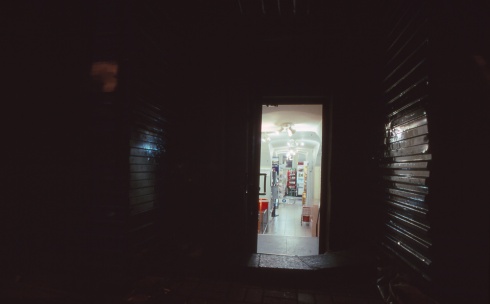
Entrance to a convenience store (or rather small twenty four hour retail market) on Kirochnaya or Kirche Street - the street where I live in St. Petersburg (about 1.5 km from the previous image), St Petersburg Saint Petersburg Russia Kodachrome late October - 2010
That’s how I missed Kodachrome during its lifetime. I shot little Agfa and then some Fuji but then went digital even before the wild masses began defecting from film. I remember seeing Kodachrome on the shelves though. Even in the 1990s Kodachrome was something of a fossil.

This is a professional 5 roll pack that contained European market Kodachrome 64 in 120 format, manufactured about 1986-1987, expired 1991. This box is in my collection but unfortunately there is no film in it. The box is twice thicker that a regular pro pack as it is divided into two sections - one contained film and the other mail-in processing envelopes. Someone used 5 rolls of film but did not process them. All five envelopes are intact. Each envelope, alas not usable after December 30, 2010, was worth about 10 euros / dollars if sold alone (those envelopes had value!) but I have no idea who bought them as each pack of European Kodachrome contained such an envelop and Kodak only dispatched processed film to non-US addresses. In America processing and optional framing had to be paid for separately. I never got hold of any 120 Kodachrome film though.
In Europe it was always sold with a processing envelope (something as I recall Kodak was prohibited from doing on its home turf because of a mid 1950s antitrust law suit that it lost ). It used to cost – as it appeared to me then – a good fortune. In Europe a roll of Kodachrome retailed for the equivalent of 20-25 euros or for whopping 30 US dollars in today’s terms or perhaps for 20 dollars with parity currency rate. Kodachrome was only sold in “real” old Europe if we were to use Donald Rumsfeld’s terminology – between 1945 and 1991. With the exception of Finland, which is a new state but was in the “Kodachrome zone” this category actually included entire “real” Europe without Russia that existed before 1917-1918. German Democratic Republic aside (on which territory a number of historic German states were located in the past), Soviet Union only held lands of newfangled states that did not exist before 1917.

Surface scan of a Kodachrome slide, processed in France (they stopped processing Kodachrome in France in the late 80s or ealry 90s). This slide dates from 70s and comes from my "collection" (a box of unsorted) slides of French origin. I have no idea whose photograph apparears on it - I just grabbed a random Kodachrome slide out of the box.
The Kodachrome border ran along the Iron Curtain and that wall that was never breached. Except for the territory of the annexed GDR, Kodachrome was never sold in the former Warsaw pact “states” or in Russia, not even after 1991. That of course was almost of irrelevance because by 1990s only some pros in the USA itself and Kodachrome enthusiasts were shooting this film. Numerous E-6 process films, probably first introduced by Kodak itself, killed Kodachrome. The price of 20-25 euros in modern equivalent (or 20- 30 US dollars ) might seem outrageous but in really it wasn’t. In America Kodachrome sold for roughly 10 dollars per roll (from 7.99 to 9.99) during the same period of time but did not include processing or framing. European price included processing, framing and return postage. So as it looks now it might have been even cheaper to shoot Kodachrome in Europe than in the US but very few did and at the end Kodachrome’s share of the film market went down to fraction of a percent.

St Petersburg (Saint Peters) Conservatory building, Theatre Square (Театральная площадь) or rather improbably in English though closer to the original as Theatrical Square - Theatralnaä Ploşad' phonetically rendered as Teatralnaya St. Petersburg, Russia Saint Petersburg Kodachrome late October 2010
In September 2010 I read somewhere, in some online blog or a magazine article, that Kodak has long discontinued Kodachrome and that it will no longer be processed. I didn’t know that. And another thing, I read, December 2010 is the cutoff date. No more Kodachrome after that. Now one disadvantage of the Kodachrome versus its competitors like Agfacolor was that you need to build more or less a factory to process the stuff. As I understand (in the plainest of layman terms) reversible Agfacolor like all subsequent films had its dyes incorporated within three photosensitive layers. You just need the right mix of chemicals to develop those films anywhere. Kodachrome had an extremely complicated processing procedure where dyes were introduced during development stage. Something that is impossible to do at home no matter how big a home you’ve got.
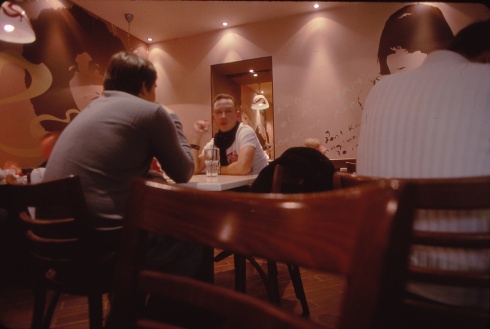
A coffee shop of the Ideal Cup (Idealnaä časka) chain, St. Petersburg (idiots write it as fantastic Saint Petersburg) - obviously Kodachrome 64 is an extremely slow film, I was shooting it as ISO 25 in dim lightining, ISO 1600-3200 would be better suited for this sort of photography, sitll quite many painterly effects - idealnaya chashka - kodachrome
Getting my hands on Kodachrome became urgent. I realized that it is now or never situation and I need to buy a few rolls of Kodachrome immediately or I’ll never process it. I saw old Kodachrome slides from the 40s and 50s, love how the film looks and wanted to take pictures of my kids on Kodachrome as well. I began to look for the stuff on the Ebay, placed random bids here and there, and amazingly got three lots of Kodachrome fairly cheaply – probably for no more than 2 euros per American roll or 3 euros for the European “issue” along with the free processing mailer. That was a good deal because I saw people selling processing envelopes for 5 euros a pop. I have no idea what they did with the film. Already after Kodachrome’s demise I bought a case of Kodak color film (all expired stuff, Vericolor II stuff, some Ektar, lots of film. I haven’t shot yet any from that batch). The precious case contained a retail pro pack of Kodachrome – alas the film was gone but all five mail-in processing envelopes were intact. What happened to the film? Who knows. Prices of Kodachrome nosedived right before November although the stuff that was unsold recovered the value after January 2011 – people sell intact Kodachrome boxes for 20 euros / 25 dollars online which are now of course only good for display purposes (developing the stuff in black and white chemistry is akin to vandalism). If I did not use my Kodachrome but kept it until today I could have made a small, admittedly a very small, fortune.

A coffee shop of the Ideal Cup (Idealnaä časka) chain, St. Petersburg (idiots write it as fantastic Saint Petersburg) - Kodachrome 64 is a slow film, I was exposing it as ISO 25 in dark lightining, ISO 1600-3200 would be better under the circumstances - still I like the results of the experiment- idealnaya chashka - kodachrome
My Kodachrome began arriving in October, I had about a month to waste it. I photographed St. Petersburg, then went with my kids on a ferry to the federal German Reich, then drove straight to Mikulov (Nikolsburg) and after a short stay there proceeded (on wheels) to Italy. By then my modest stock of expired Kodachrome ran out. Because of urgency I felt I have to take pictures fast and with any sort of rush quality suffers. I packed everything and sent it off to Kodak (in Switzerland, that was the last place in Europe that still took Kodachrome and forwarded it to Dwayne’s lab in the states). I got it back right after new year.

A coffee shop of the Ideal Cup (Idealnaä časka) chain, St. Petersburg fisheye lens (that's one of the things you must get but then won't use). Zenit camera
I believe I might have been the last person who used Kodachrome in either Russia or the Czech Republic (where it was never sold anyway). Flickr has few, very few, fantastic Kodachrome images of Leningrad, all taken by tourists in the 1970s and early 80s. Time frozen. But nothing afterwards.
I am crazy about historic film and for me the experience of shooting Kodachrome and getting it developed was almost a divine pleasure. I am also happy that I now got some Kodachrome photos on my own. I am thankful to Kodak that they kept it going for so long.
At 75 years (1935-2010) Kodachrome is or rather was the longest surviving photographic process. With its 59 years Agfacolor which later became a ‘chrome (such as German Orwochrom) came second but a disclaimer should be made that it is still possible and in fact is fairly easy to process any Agfacolor / Orwochrom type filmstock at home. If years of film production are to be counted, and that would be fairer, Kodachrome’s lifespan would have to be reduced by a year to 74 but factually by 8, from 75 down to 67 as most of Kodachrome production stopped in 2002. I couldn’t locate any film fresher than that for my experiment. Nonetheless, even with that reduction Kodachrome still outlived its Agfa contemporary by almost a decade. I am unsure if color film stays in production for three more decades from now, that’s how much time is needed for the current C-41 and E-6 films to beat Kodachrome’s longevity record.

A rare example of private urban architecture (http://www.citywalls.ru/house1855.html) albeit much mutilated one. The townhouse or private house of architect Theodore Demercev (hated Americanized "spellers" might render his name in the language of Donald Rumsfeld and Obama as Fyodor Demertsev or worse), built in 1792. This elegant neoclassical building was apparently mutilated for commercial ends - in 1826 another massive floor was added on top of the structure. Kodachrome Zenit camera October 2010
Lifespan of commercial photographic color film processes:
Autochrom / Alticolor (France) – from about 1907 to 1955 = 48 years
Dufay / Dufaycolor – France / Great Britain – from mid 1920s to until 1940, about 15 years.
Kodacolor (C-22) 1943-1972 (first Kodak then internationalized) =29 years
Kodachrome – 1935 to 2010 =75 years
Agfacolor reversible / Orwochrom – 1932 to 1991 = 59 years
Kodak C-41 and similar international processes (Fuji, Agfa) 1972 until today, the current most common negative process, 40 years, still alive.
Kodak E-3 reversible, about 1950 to 1972 – 22 years
Kodak E-4 reversible, 1972-1974 – 2 years
Kodak E-6 and its international derivatives, 1974 until today, 38 years, still alive.

European market Kodachrome 64 120 format box

Kodachrome 64 120 5 pack - Kodak officially discontinued the film in 1996 but probably stopped making it even earlier.
Tags: 2010, 2011, Agfacolor, analog, analogue, color, digital, dufay, film, images, kodachrome, Kodak, lomo, lomography, Minolta, Orwochrom, orwochrome, photos, pics, pictures, prepaid, process, processing, Russia, Saint, Soviet, St. Petersburg, St. Vladimir, streets, Union, Zenit



